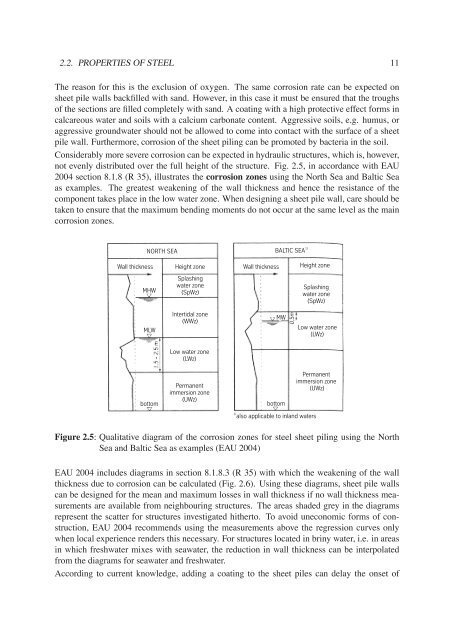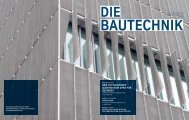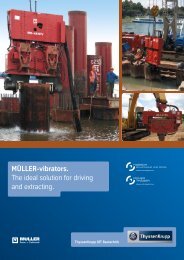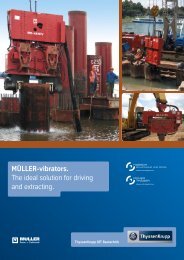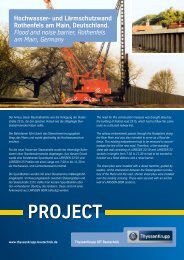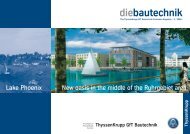pdf (3.6 MB) - ThyssenKrupp Bautechnik
pdf (3.6 MB) - ThyssenKrupp Bautechnik
pdf (3.6 MB) - ThyssenKrupp Bautechnik
Create successful ePaper yourself
Turn your PDF publications into a flip-book with our unique Google optimized e-Paper software.
2.2. PROPERTIES OF STEEL 11<br />
The reason for this is the exclusion of oxygen. The same corrosion rate can be expected on<br />
sheet pile walls backfilled with sand. However, in this case it must be ensured that the troughs<br />
of the sections are filled completely with sand. A coating with a high protective effect forms in<br />
calcareous water and soils with a calcium carbonate content. Aggressive soils, e.g. humus, or<br />
aggressive groundwater should not be allowed to come into contact with the surface of a sheet<br />
pile wall. Furthermore, corrosion of the sheet piling can be promoted by bacteria in the soil.<br />
Considerably more severe corrosion can be expected in hydraulic structures, which is, however,<br />
not evenly distributed over the full height of the structure. Fig. 2.5, in accordance with EAU<br />
2004 section 8.1.8 (R 35), illustrates the corrosion zones using the North Sea and Baltic Sea<br />
as examples. The greatest weakening of the wall thickness and hence the resistance of the<br />
component takes place in the low water zone. When designing a sheet pile wall, care should be<br />
taken to ensure that the maximum bending moments do not occur at the same level as the main<br />
corrosion zones.<br />
Figure 2.5: Qualitative diagram of the corrosion zones for steel sheet piling using the North<br />
Sea and Baltic Sea as examples (EAU 2004)<br />
EAU 2004 includes diagrams in section 8.1.8.3 (R 35) with which the weakening of the wall<br />
thickness due to corrosion can be calculated (Fig. 2.6). Using these diagrams, sheet pile walls<br />
can be designed for the mean and maximum losses in wall thickness if no wall thickness measurements<br />
are available from neighbouring structures. The areas shaded grey in the diagrams<br />
represent the scatter for structures investigated hitherto. To avoid uneconomic forms of construction,<br />
EAU 2004 recommends using the measurements above the regression curves only<br />
when local experience renders this necessary. For structures located in briny water, i.e. in areas<br />
in which freshwater mixes with seawater, the reduction in wall thickness can be interpolated<br />
from the diagrams for seawater and freshwater.<br />
According to current knowledge, adding a coating to the sheet piles can delay the onset of


